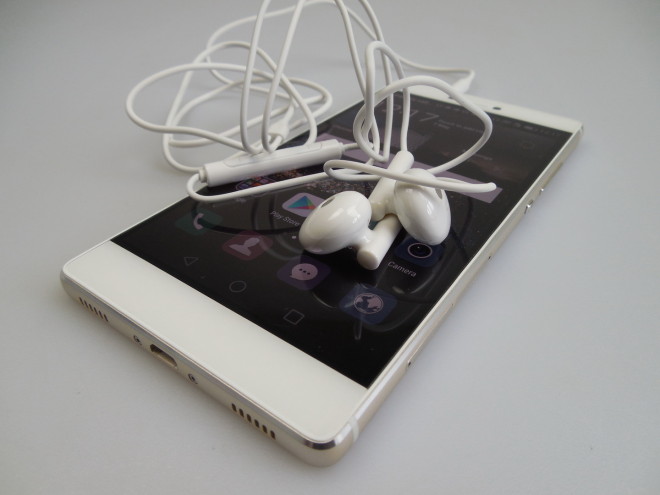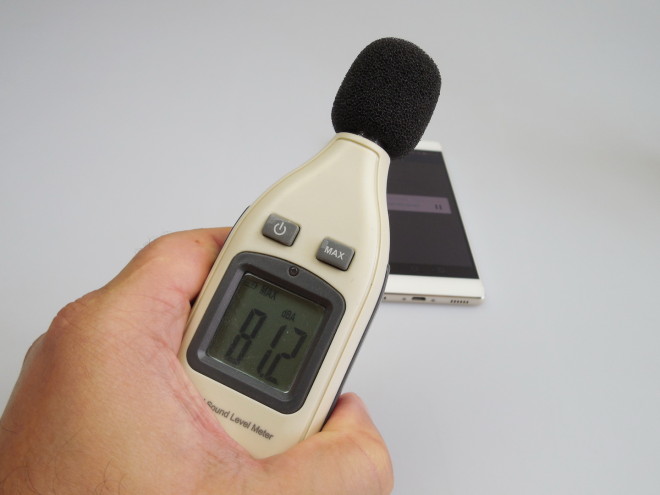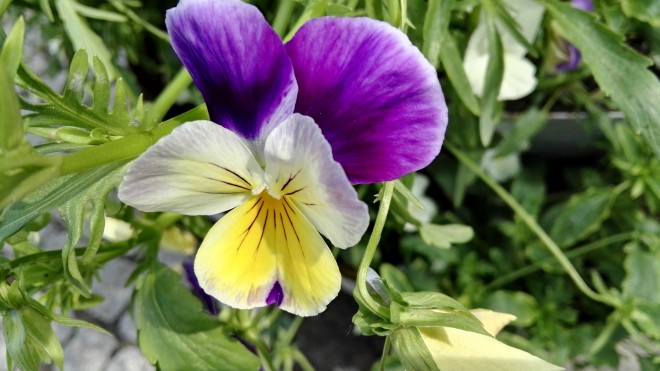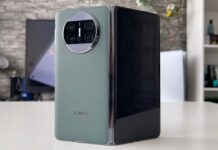Huawei P8 is sort of the banner holder for Huawei right now, not exactly a flagship, but the main phone to bank on for the next months. Unveiled last month in London, the product came to us for testing purposes and it’s an ultraslim affair, priced at 499 euros in the 16 GB version, with a Kirin 930 CPU. The 64 GB model with a Kirin 935 CPU costs 599 euros in Europe.
We’re testing the 16 GB model by the way. This phone is an ultraslim one, at 6.4 mm in waistline, being slimmer than the iPhone 6, at 6.9 mm, but also heavier. P8 weighs 144 grams, which is 15 grams more than the iPhone 6 and 20 grams heavier than the Huawei P7. Well, at least the newcomer is 0.1 mm thinner than its predecessor. It comes with an aluminum unibody chassis, an angular design and a back texture that feels like sand or chalk.
It offers good grip and this smartphone comes with both a flat back and front. It has very narrow bezels and the combo of glass and metal feels premium. This device is longer and wider than the P7 and you can spot 2 shiny metal lines on the sides, that look great in sunlight. Huawei P8 is made using nano molding technology, that hides the plastic antenna cutouts.
Upfront we find the discrete earpiece and sensors, as well as the camera and on the right side there’s the notification LED. At the back there’s the main camera, with dual LED flash and the plastic cutouts. At the top we can find the microphone and audio jack, while at the bottom there are the speakers (only the left one, the right side grill is probably for an extra mic) and microUSB port.
There’s nothing on the left side, while on the right we find the volume buttons and the On/Off button, that’s a bit too small to be comfy. There are also two slots here, with the upper one being used for either microSD or SIM, depending on what you need. The bottom slot is a nano SIM card tray. Overall, the P8 is a comfy phone, with easy one hand use and a solid case. It’s better looking than the HTC One M9 and its back side is more pleasant than the one of the iPhone 6.
The hardware includes an IPS LCD screen, a 5.2 inch Full HD unit, accompanied by an octa core 64 bit processor, a HiSilicon Kirin 930. It has 4 cores of the Cortex A53E kind, clocked at 2 GHz and 4 cores of the Cortex A53 kind, clocked at up to 2.2 GHz. The GPU is a Mali T628, according to info on the web, or a T624, according to the CPU-Z app.
There’s 3 GB of RAM available here, plus 16 or 64 GB of storage and we’ve got a microSD card slot in the mix, with support for up to 128 GB extra storage. The back cam is a 13 MP one and the front cam offers an 8 MP resolution. On the connectivity side there’s LTE Category 6, NFC, GPS, Glonass, WiFi b/g/n, WiFi Direct and Bluetooth 4.1.
There’s also microUSB connectivity, HSPA, DLNA and FM radio, while the sensors list includes the G Sensor, gyroscope, ambient light sensor, proximity sensor, compass and accelerometer. The battery is a 2680 mAh unit (Li-Po), an upgrade from the P7’s 2500 mAh power unit. In our test, that involves HD video playback with WiFi on and brightness at 50%, we achieved 6 hours and 55 minutes, which is not very impressive.
For example, we were beaten by the Amazon Fire Phone, that scores 7 hours and 10 minutes, but at least we beat the HTC One M9, that scores 6 hours and 9 minutes. Strangely, our time was lower than the one of the low end Xperia E4, that achieves 7 hours and 18 minutes. We also did a PCMark test, that involves a simulation of continuous usage, with brightness at 200 LUX.
Here we achieved a reasonably good time, of 5 hours and 31 minutes, beating the OnePlus One and its 5 hours and 15 minutes, but scoring below the Galaxy A5 and its 6 hours and 51 minutes. Overall, the time achieved is OK, but not more than that. The charging takes 2 hours and 47 minutes, also unimpressive, especially when compared to the Galaxy S6 and its 1 hour and 10 minutes of charging, or the OnePlus One and its 1 hour and 15 minutes.
In the Settings area we’ve got Power Saving options that feel familiar from other Emotion UI devices. There’s Power Monitoring that analyzes your device behaviour and figures out which apps are draining too much battery. It also offers advice on how to save power, by decreasing brightness or tweaking down connectivity. There’s also a feature called Power Plan, that includes a few Power Saving modes like Ultra, which only offers a monochrome UI and access to basic features, plus a minimalistic UI.
There’s also Smart, that auto adjusts CPU usage and network usage and then Normal, that only does slight adjustments. Other options include a list of apps allowed to run in standby mode and WiFi On/Off in Sleep mode. Now we move on to the acoustics, discovering that the speaker is easy to cover when playing games or watching video. The music player we’ve got here is minimalistic and hasn’t changed from Emotion UI 3.0.
There are no special options here, like an equalizer or visualizer. The actual experience is very loud and we also get a good bass and clear sound. At the max volume there’s a slight distortion happening. I also noticed that sometimes the virtual buttons of the player didn’t respond to my commands. The headphones offered here have a long plastic body and they feel a bit like the Apple Earpods.
They have a big remote, with flimsy buttons and the wire can tangle easily. The listening experience when using the headphones is loud and clear and they offer very good isolation and good bass. These are comfy headphones and with DTS on we get some extra bass and a more natural sound. There’s also FM radio here, with very fast station detection and a nice looking UI.
We used a decibelmeter to test the speaker output and found a value of 81.2 dBA at the front and back. We are above the Huawei Honor 6 and its 81 dBA and certainly above the Galaxy A5 and its 77.6 dBA. Obviously we are below the Galaxy S6 and its 89 dBA. Acoustics are good overall, maybe aside from the max volume distortion. The display of the P8 is a 5.2 incher, with a Full HD resolution and an IPS LCD panel, made by JDI. The video player also has the DTS option and the first thing I noticed was that the image felt cropped, because the narrow bezel approach actually left a black edge available to the sides, top and bottom, that felt a bit annoying.
This screen offers OK contrast, vivid colors, an oversaturated image, good brightness and wide view angles. The pixels are of the RGB Stripe kind and the brightness level is at 346 LUX, not very impressive to be honest. We are below the Oppo Find 7a and its 354 LUX, but above the LG G Flex 2 and its 266 LUX. We’re even below the disappointing HTC One M9 and its 362 LUX units.
However, in day to day activities, like watching videos or playing games, the screen felt bright enough. The settings area reveals display options, like Color Temperature and a slider what lets you set it up to Warm or Cold. You can also change the font size and style and overall the screen is good, but not groundbreaking. Moving on to the camera, we’ve got here a 13 megapixel shooter with OIS and a Sony RGBW sensor, as well as F/2.0 aperture.
There’s an 8 megapixel selfie camera and back to the main shooter, the RGBW thing means “Red Green Blue White”, where the fourth pixel is white and could be used to gather more light. Huawei claims that this sensor gets 32% higher brightness in high contrast conditions and 78% less color noise in low light. They also included a DSLR-level image processor and the optical image stabilization mechanism is made to compensate for vibrations by 1.2 degrees, which is double compared to the iPhone 6 Plus.
The UI of the camera is simple and very similar to the one of the Honor 6, only we can see the Settings icons in landscape now. The camera app doesn’t start up very fast and on the left side of the UI we’ve got the main options section, with capture modes like HDR, Watermark, Super Night, Best Photo, Panorama, All Focus and Audio Note.
Then there’s resolution with the 13 MP setting, at 4160 x 3120 pixels in 4:3 or 10 megapixels, at 4160 x 2336 pixels in 16:9. GPS Tagging is also here, as well as a feature called Perfect Selfie, that lets you take a couple of shots of your face from various angles and use them as presets for future shots, while also tweaking the face width, eye clarity, size and more.
The list of options goes on with Mute, Voice Control, Timer, Touch to Capture, Auto Smile Shot, OIS, Object Tracking, Burst Shot and volume button features. There’s also Ultra Snapshot using volume keys and then ISO going up to 1600 and the Image Adjust options: Exposure, Saturation, Contrast and Brightness. I have to back to the Super Night mode a bit, probably the most interesting offered by this device.
It requires a tripod or steady mechanism and requires 30 seconds of your time. Playing with exposures and aperture it gets an incredibly well lit shot, even in pitch black scenery. The All Focus feature allows you to refocus after taking a shot and getting back to the camera UI, also on the left side you’ll find the front camera shortcut.
The selfie camera has a beauty slider, a method to increase brightness and features like watermark, mirror, panorama or audio note, as well as Full HD filming. There’s also ISO and white balance. On the right side of the UI there are the main capture functions, such as Photo, Beauty, Video, Time Lapse and Light Painting. The latter creates light traces using the cars that pass you by at night and there are other associated options like water fall effects and star tracking. Filters are also available here and the video options include FHD filming with stereo acoustics, object tracking, OIS and digital stabilization.
The actual camera experience involves a fast focus, OK capture speed and if you keep the screen pressed, you can adjust focus and metering point. The zoom gets to about 6x and it’s pretty fluid. The camera is also able to auto sharpen the image when required. We’ve also got an exposure slider when tapping on the screen, in pure iOS fashion.
And now let’s analyze the pictures we’ve taken. We have a full gallery here, with shots taken on a sunny day, as well as night time here. During the day the colors are realistic, but overall the shots are less “glossy” and shiny than those taken with a Galaxy S6. You can clearly see less details in the distance compared to modern 2015 flagships. I noticed the camera captures a lot of light and we tested the refocusing in the picture of the dog sign and flowers and it worked just fine.
I liked the blue hue here, with an excellent rendition of the sky. The statues we caught on camera had good texture and sadly, the quality drops a lot when zooming in. I found the macros to be exceptional, with a few flowers caught during our tests. Exposure and white balance were top notch, while the panorama was pretty wide at 12.736 x 2176 pixels.
The Huawei P8 camera takes shots with great detail at up to 2 or 3 meters, but the landscape shots are unimpressive. It has no problem with a sunny day and it doesn’t burn shots. The selfie camera finally takes a decent shot of the background, not only the human face serving as subject. In the shade the pics were crisp and HDR of the ducks was fine.
Night time capture proved to be fine, with OK colors, a very powerful flash and in the usual test conditions, images were a bit darker than expected. Colors were reasonably realistic even without a flash. We caught the light source well, without a halo around it and the image didn’t suffer from the yellow-ish hue that plagues some phones.
Still, the night time capture was below the LG G Flex 2 and iPhone 6 Plus, but the Super Night mode remains fantastic, turning night into day basically. We also tested the video capture and I have to mention there’s no 4K filming here, no slow motion or other fancy options. Video is taken in Full HD, MP4 format, 29 FPS, low bitrate of 9 or 10 Mbps, compared to other phones that get past 20 Mbps.
The first video we captured was sun burnt and out of focus a bit, while the second video had an OK exposure change, good acoustics and poor stabilization. The third video registered poor zoom quality and good exposure change again. The fourth video had good image quality, but once again without the 2015 gloss we feel the need to see.
The fifth video was the one that tested the optical image stabilization and its advantage was that it kept focus intact. It’s still not better than the iPhone 6 Plus OIS. Video 6 was in the shadows and it didn’t impress very much. The night time video showed poor capture without flash, but with flash everything was simple fine: a clear and crisp image, good colors, but still a bit of grain was there.
Overall, the filming felt underwhelming. I’d say this camera is certainly not on a flagship level, but the pictures were quite good, close to the iPhone 6 level, however certainly not close to the Galaxy S6 or G Flex 2. Videos are very far from all rivals, sadly for Huawei. Super Night is still a blast to use. Editing photos is done by rotating, cropping, using filters, mosaics and watermarks.
Moving on to performance, we scored 35.8 degrees Celsius after playing 15 minutes of the game Riptide GP2, so there’s no overheating here. The web browser on board of the handset is fast and the device’s virtual keyboard has big, big keys, comfy to use. The phone calling part offers a clear and loud experience, plus good signal and crisp sound.
And now off to the benchmarks! We compared the Huawei P8 with the P7, LG G Flex 2 and Allview X2 Soul Pro. This is a battle between an 8 core HiSilicon Kirin 930 and 3 GB of RAM with a 4 core HiSilicon Kirin 910 accompanied by 2 GB of RAM and then with the Snapdragon 810 octa core with 2 GB of RAM and finally an 8 core MediaTek MT6752 processor and 2 GB of RAM.
Here are the results:
The P8 wins 2 out of the 11 battles and compared to the P7 it wins all of them. There’s no lag here and the handset runs Riptide GP2 without a hassle. The OS here is Android 5.0.2 with Emotion UI 3.1 on top. The interface is flat, but still colourful and there’s not much gloss here. All the apps are placed on homescreens and there’s no app drawer here.
The basic features here are circular UI elements, transparency and loads of white text. The core of Emotion UI 3.0 hasn’t changed very much, if we’re really being honest. We do get new hues in the mix. If you keep the homescreen pressed, you will trigger the wallpapers area, as well as the widgets, transitions and home settings. You can trigger a home screen loop or arrange icons on a 4 x 5, 5 x 4 or 5 x 5 setup.
The multitasking is done in a similar fashion to HTC’s phones, however with 4 thumbnails per screen not 9. You swipe up to close apps. The notification area is transparent and offers a timeline of all events. The Quick Settings portion is also transparent and it’s based mainly on connectivity options. The Settings area offers features like Home Screen Style (Simple or Standard), Smart Unlock, Do Not Disturb, Speech Awareness (Find phone with vocal commands), Touch Plus, Motion Control, Nav bar settings and One Hand UI.
In the More area you can find the Suspend button, a floating widget with virtual Android buttons, as well as the brand new and advertised Huawei feature involving finger knuckles. You touch the screen with knuckles to take a screenshots or keep the knuckle on the display to cut a part of the image. And now let’s have a look at the preinstalled apps list. It includes the following: Email, Phone Manager (accelerator, cleaner, harassment filter and power saver), Notepad, Themes, Calendar, Files, Director Mode (control several feeds of video from other phones and edit them), plus Zinio, To Do Ist and Weather.
Then there’s Calculator, Recorder, Mirror, Magnifier, Backup Update, Torch, Hi Care and Magic Tag. We’ve also got games here, like Real Football 2015 and a few other titles. The usual suite of Google Apps is available, stuff like Google+, Maps, Gmail and more. If you swipe down on the homescreen, you’ll trigger an iOS-like Search bar.
If you swipe down in the lockscreen you’ll find some media controls and shortcuts to functions like Torch, Calculator and camera. And I guess it’s time for the verdict!
Here are the Pros:
- premium design
- good price
- loud speaker
- good screen
- great macros
- Super Night is a blast to use
- Light Painting is nice
- Good optical image stabilization
- very good selfie camera and extra camera features
- nice looking UI
And the Cons:
- image feels cropped because of black edges
- not very impressive battery
- speaker easy to cover
- could be brighter
- video capture could be better
- bloatware on board
- knuckle feature is a gimmick
We give this phone a 9.2 out of 10 for design, a 9 for hardware and 9.3 for OS and UI. The final grade is 9.16 out of 10 and while you’re rushing to compare this to an iPhone or Galaxy S6, remember the price tag of just 500 euros. It’s a good selfie phone and has an appealing design, plus a variety of unique camera features and good audio. It’s also great for gaming. Basically, it’s an iPhone with Android and it owns up to that.






























































































